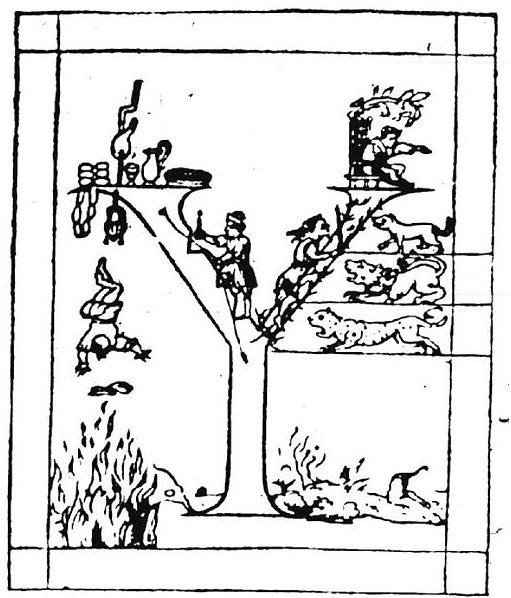I here - at ζ Persei (Menkhib according to my list) - discovered that ξ Persei (Menkhib according to Wikipedia) was missing in my star list. Moreover all the 24 Greek lettered stars in Perseus should be in my list, not only these 5:
However, 3 (blackmarked below) of the remaining 19 Greek lettered stars appeared not to be visible in Wikipedia's star map above.
Pythagoras' letter (Υ, υ) is used in my astronomy book for the star which Bayer gave the Roman letter c and which Flamsteed designed as 48 Persei. For what reason did Bayer avoid upsilon in Perseus? ... As the Roman writer Persius [not Perseus] wrote in Satire III: 'and the letter which spreads out into Pythagorean branches has pointed out to you the steep path which rises on the right' ...
Was it because the highest number for the right ascension hours was 23? As to φ and χ these stars would have been problematic for the map maker. The position of χ was at the yellow spot where 869 / 889 had to be and the letter φ had to be placed just outside the white area intended for the Perseus constellation. Therefore I could not at first find φ, which is just above the line for declination 50° N and below Messier 76 (indicated by a green symbol). In my old astronomy book Algol has been listed with right ascension 3h 05m, which I then converted into my 'right ascension days' via the formula 185m / 1440m * 365.25 = 46.9, which in turn then would correspond to the approximate theoretical value of 46.9 / 365.25 * 1440m = 184.903m. Due to the precession the current Wikipedia position for Algol was a few minutes later, viz. at 03h08m10.13s (according to the epoch J2000.0). This value can then be used for extrapolating backwards in time the earlier right ascension positions of the other stars:
For instance would the corresponding approximate position of φ (disregarding the proper motion of the star) have been equal to right ascension day 46.9 - (03h08.169m - 01h43.660m) / 24h * 365.25 = 46.9 - (188.169m - 103.660m) / 1440m * 365.25 = 46.9 - 21.4 = 25.5 - a value which in turn could be expressed as ca 25.5 / 365.25 * 1440m = 100.534m = 01h40.534m (to be compared with 01h43.660m according to J2000.0). In my presentations of the right ascension days at the time of rongorongo I have assumed the precession would have moved the star positions with 1 more day, and φ Persei would accordingly be at a glyph (like Gb4-5) which was representing right ascension day 24 (= 25.5 - 1 and then truncated). Day 24 after 0h would have been day 80 + 24 = 104 counted from January 1, i.e. April 14 (4-14). 64 right ascension days earlier (at the time when Ain rose with the Sun at 0h) φ Persei would have risen heliacally in day 104 - 64 = 40 = FEBRUARY 9 (disregarding the proper motion of the star and assuming 26000 years for a complete precessional cycle). My starlist also includes declinations, proper names, and visibility:
The very faint χ Persei (5.99) can be explained as a value referring to the star and not to the brighter NGC884, which object according to Wikipedia often was referred to as χ Persei. |

